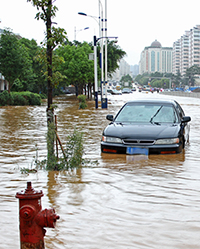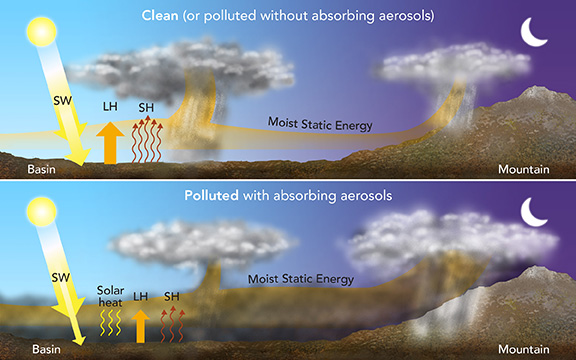Atmospher Sci & Global Chg
Research Highlights
July 2015
Air Pollution Amplified Extreme Weather, Floods in China
PNNL researchers find mechanism that ties human-caused air pollution to catastrophic floods in southwest China

The 2013 Sichuan Flood in China killed up to 200 people with hundreds more missing. It was a 50-year event with up to 17 inches of rain from July 8-13, causing mudslides and disrupting the lives of over 6 million people. PNNL researchers found that human-caused pollution boosted the severity of the heavy rainfall.
Results: Following the trail of the 2013 Sichuan flood in southwest China, researchers from Pacific Northwest National Laboratory and their collaborators found that heavy human-caused air pollution over the Sichuan Basin just upwind contributed to the catastrophic flood. Through a series of events they call "aerosol-enhanced conditional instability," tiny particles from heavy air pollution absorb heat from the sun, stabilize the atmosphere, and suppress local storms during the daytime. However, this allows the heavy moist and now warm air to be transported downwind to mountainous areas where it is lifted causing extreme nighttime precipitation. The research was published in Geophysical Research Letters and highlighted by Nature.
"We found a mechanism that could escalate a normal storm event to a severe weather event, particularly in downwind mountainous areas where storms can be triggered by the topography," said Dr. Jiwen Fan, PNNL atmospheric scientist and lead author of the study.
Why It Matters: Heavy air pollution has increased rapidly in regions such as China and India, where economic growth and urban populations are booming. Researchers have observed increases in the frequency and intensity of regional floods and droughts over the past few decades. This study establishes a clear connection between severe air pollution and extreme weather events. While this finding covers Southeast China, the mechanism that triggers the extreme weather events would apply to other regions in developing countries with similar topography and pollution levels. Even though the flood was the worst in 50 years in Sichuan, the weather forecast missed it, potentially because the pollution effect discovered in this study is not included in weather forecast models. The significance of human-caused pollution emissions to modify weather and climate is the important finding of this study. Understanding that reducing pollution locally in the Sichuan Basin would substantially alleviate downwind floods has important socioeconomic implications and is especially useful for policy-makers.
Methods: Led by PNNL, the researchers carried out model simulations of the catastrophic flood event and associated sensitivity simulations. They conducted ensemble simulations at a convection-permitting scale (3 km) using the improved chemistry version of the Weather Research and Forecasting Model (WRF-Chem), a regional-scale model.

Illustration of the mechanism the researchers call “aerosol-enhanced conditional instability.” Polluted air containing strong, heat-absorbing particles (bottom panel) suppresses daytime rainfall in the Sichuan Basin, allowing the warm, moisture-laden air to be transported to the mountains downwind. There, it is lifted by topography and dumps heavy rainfall during nighttime. The research finds that reducing local pollution in Sichuan Basin would have substantially alleviated the severity of the 2013 Sichuan flood event.
What's Next? The group is exploring aerosol impacts on other mountainous regions in China to better understand how they may vary in different regions and different meteorological conditions.
Acknowledgments
Sponsors: This study was supported by the U.S. Department of Energy (DOE) Office of Science Biological and Environmental Research as part of the Regional and Global Climate Modeling program (RGCM), and the Chinese Ministry of Science and Technology.
Research Team: Jiwen Fan, Yan Yang, Chun Zhao, and L. Ruby Leung, PNNL; Daniel Rosenfeld, The Hebrew University of Jerusalem; and Zhanqing Li, the University of Maryland.
Research Area: Climate & Earth Systems Science
Reference: Fan J, D Rosenfeld, Y Yang, C Zhao, LR Leung, and Z Li. 2015. "Substantial Contribution of Anthropogenic Air Pollution to Catastrophic Floods in Southwest China." Geophysical Research Letters, early online. DOI: 10.1002/2015GL064479
